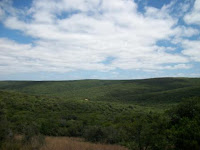The quote on one of the buses was thought provoking--The journey's never long when freedom is the destination. Jama said that the prisoners wanted Robben Island to be a place of hope and triumph. As I took the bus tour, I questioned how that hope and triumph happens. Certainly, Mandela's life speaks to that. But, what is the hope and triumph for South Africa? Former Model C Schools are still schools for white students. They are still better. The living conditions of most of our students was beyond impoverished. It makes me angry to know that there are such deplorable living conditions in a democratic country. What is the promise of democracy if it cannot ensure that everyone has access to a basic standard of living? Our visit to Kama Primary ended with a small group of students singing a song that, perhaps, captures the hope of South Africa. To see the students singing, click on: Kama Primary: Never Give Up
On Sunday evening, we had dinner at the State House in Cape Town with South African First Lady, Bongi Ngema-Zuma. Though we did not talk at any length about the economic and social problems of South Africa, she did mention them. She clearly understands what they are. Eating dinner with her stood in stark contrast to the lunches we shared with our students at Emafini, many of whom ate soup from the soup kitchen at school. On Tuesday, we flew home. It was bittersweet. Yes, we wanted to come home, but we also found ourselves tied to South Africa. It is a country that draws one in and makes one want to stay awhile.





















